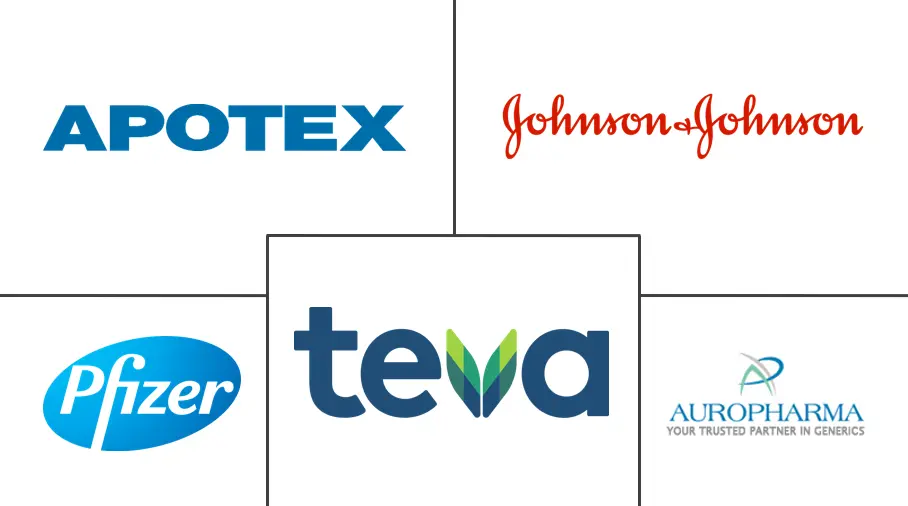Frontotemporal Disorders Treatment Market Size and Share
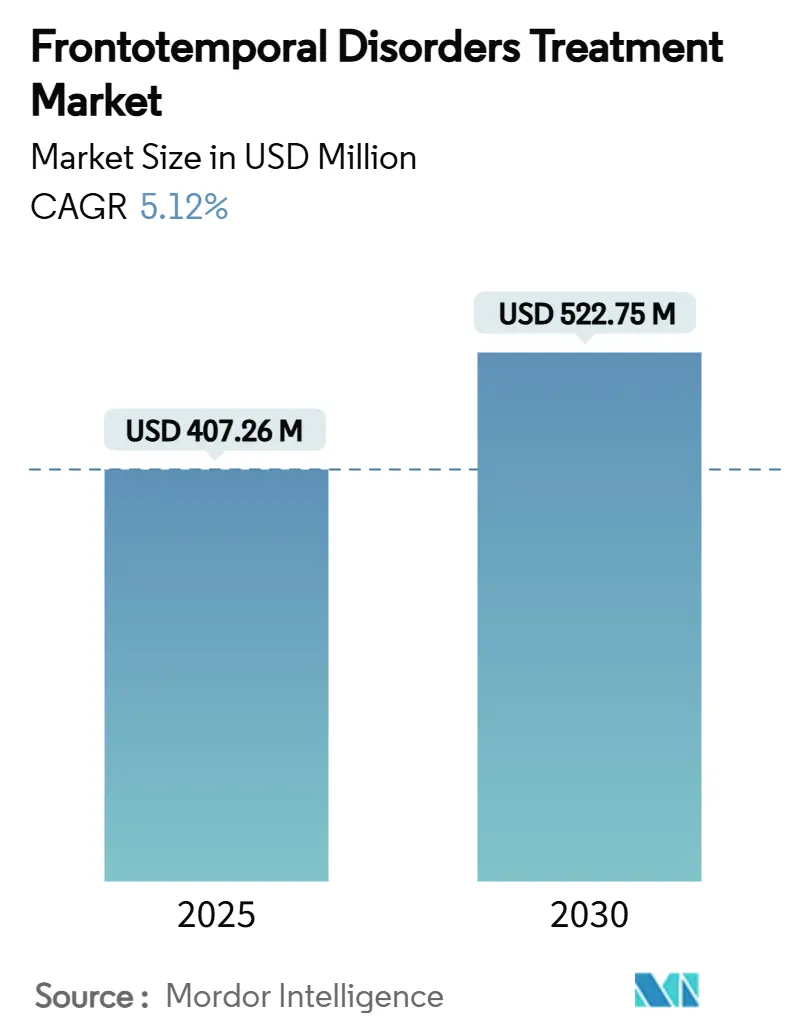
Frontotemporal Disorders Treatment Market Analysis by Mordor Intelligence
The frontotemporal disorders treatment market size stands at USD 407.26 million in 2025 and is expected to reach USD 522.75 million by 2030, reflecting a 5.12% CAGR. Steady expansion is underpinned by the first wave of disease-modifying gene therapies, wider biomarker-based diagnostics, and sustained public funding for rare neurodegenerative research. Antipsychotics still anchor revenues, yet clinical momentum has shifted toward progranulin-targeted antibodies and adeno-associated-virus vectors that promise earlier intervention. Hospitals retain a central role in complex infusion delivery, but payer support for at-home care is nudging volumes toward retail channels. Regionally, North America benefits from Medicare coverage decisions that shorten the adoption curve for breakthrough assets, while Asia-Pacific capitalizes on rapid dementia prevalence growth to post the fastest regional gains. Investor confidence remains high, demonstrated by multiple USD 100 million-plus rounds funneled into precision-medicine startups.
Key Report Takeaways
- By drug class, antipsychotics held 38.54% of the frontotemporal disorders treatment market share in 2024; CNS stimulants are forecast to expand at a 7.43% CAGR through 2030.
- By disease indication, frontotemporal dementia accounted for 48.56% share of the frontotemporal disorders treatment market size in 2024, while movement disorders are advancing at an 8.23% CAGR through 2030.
- By distribution channel, hospital pharmacies controlled 46.23% revenue share in 2024; retail pharmacies record the highest projected CAGR at 8.65% to 2030.
- By geography, North America led with 41.55% share in 2024 and Asia-Pacific is projected to rise at a 6.45% CAGR through 2030.
Global Frontotemporal Disorders Treatment Market Trends and Insights
Driver Impact Analysis
| Driver | % Impact on CAGR Forecast | Geographic Relevance | Impact Timeline |
|---|---|---|---|
| Rising global dementia burden | +1.2% | Global – strongest in North America & Europe | Long term (≥ 4 years) |
| Government funding and orphan drug incentives | +0.8% | North America & EU, expanding to Asia-Pacific | Medium term (2-4 years) |
| Advancements in neurodegenerative biomarkers | +1.0% | Global, led by North America | Medium term (2-4 years) |
| Pipeline expansion of disease-modifying therapies | +1.5% | Global, early gains in North America | Long term (≥ 4 years) |
| Increasing venture capital in neurotherapeutics | +0.7% | North America & Europe, spill-over to Asia-Pacific | Short term (≤ 2 years) |
| Growing diagnostic awareness and screening programs | +0.9% | Asia-Pacific & emerging markets; support from developed EU | Medium term (2-4 years) |
| Source: Mordor Intelligence | |||
Rising Global Dementia Burden
Frontotemporal disorder prevalence is accelerating worldwide, with Asia-Pacific now mirroring Western incidence patterns after fast urbanization and increased life expectancy. Health systems respond by embedding biomarker-based triage into neurology pathways, aligning with the FDA’s 2024 guidance that encourages surrogate endpoint use in trials[1]Office of the Commissioner, “Rare Neurodegenerative Disease Grant Program,” FDA, fda.gov. The U.S. GUIDE Dementia Model introduced coordinated caregiver reimbursement, broadening patient support networks[2]Centers for Medicare & Medicaid Services, “GUIDE Dementia Model,” Medicare, medicare.gov. Budget planners warn that delayed diagnosis inflates long-term care costs, creating impetus for earlier screening programs across primary care.
Government Funding and Orphan Drug Incentives
Federal and philanthropic bodies have earmarked significant grants—such as the U.S. Department of Defense’s USD 650 million 2025 Alzheimer’s Research Program—to stimulate translational dementia studies[3]U.S. Congress, “FY 2025 Defense Appropriations Act,” Congress.gov, congress.gov. Orphan-drug status continues to compress review timelines; latozinemab secured breakthrough status, potentially slicing 6–12 months from evaluation. Global alliances, exemplified by the Treat FTD Fund’s USD 10 million extension through 2035, mitigate commercial risk and maintain momentum for rare-disease pipelines.
Advancements in Neurodegenerative Biomarkers
Blood-based assays that read progranulin or neurofilament light now enable risk stratification outside tertiary centers, reducing trial-screen failure rates and shaving months off recruitment. Smartphone cognitive-testing apps show sensitivity on par with clinic visits and correlate with MRI-measured atrophy. The YWHAG:NPTX2 protein ratio outperforms legacy panels in forecasting cognitive decline, guiding enrichment of disease-modifying trials.
Pipeline Expansion of Disease-Modifying Therapies
AviadoBio’s AVB-101 attracted an Astellas option deal worth up to USD 2.18 billion, underscoring confidence in progranulin gene-replacement platforms. PR006A elevated cerebrospinal progranulin into the normal range for 75% of treated subjects at 12 months, validating vector delivery approaches. Parallel small-molecule programs—such as benzoxazole derivatives that correct lysosomal dysfunction—illustrate pharmacological diversification beyond monoclonal antibodies.
Restraints Impact Analysis
| Restraints Impact Analysis | (~) % Impact on CAGR Forecast | Geographic Relevance | Impact Timeline |
|---|---|---|---|
| Limited disease-modifying treatment approvals | –0.9% | Global, most pronounced in emerging markets | Medium term (2-4 years) |
| High development and therapy costs | –0.6% | Global, varying by healthcare-funding model | Long term (≥ 4 years) |
| Clinical trial recruitment challenges | –0.7% | Global, acute in ultra-rare genetic subtypes | Short term (≤ 2 years) |
| Reimbursement uncertainties for novel therapies | –0.5% | North America & EU; emerging Asia-Pacific payers | Medium term (2-4 years) |
| Source: Mordor Intelligence | |||
Limited Disease-Modifying Treatment Approvals
Late-stage attrition remains high; Roche terminated a tau-antibody program after suboptimal efficacy, returning rights to partner UCB. The FDA demands rigorous surrogate-endpoint validation, compelling sponsors to run parallel biomarker studies that extend timelines[4]Regulatory Affairs Professionals Society, “Surrogate Endpoints in Neuro Trials,” RAPS, raps.org. Misdiagnosis—estimated near 70% in early FTD referrals—adds enrollment complexity, forcing firms to widen geographic footprints for trials.
High Development and Therapy Costs
Vector-based one-time infusions push six-figure price points as firms build manufacturing suites and maintain long-term registries. Medicare’s Leqembi budget impact foreshadows similar scrutiny for FTD gene therapies, with payers signalling tighter evidence-development mandates. Specialized neurosurgical delivery confines access to academic centers, raising equity concerns and reinforcing the need for value-based contracts.
Segment Analysis
By Drug Class: Antipsychotics Maintain Volume Leadership While Stimulants Surge
Antipsychotics retained 38.54% revenue share of the frontotemporal disorders treatment market in 2024, cushioning overall sales while clinical practice transitions toward mechanism-based drugs. Uptake persists because behavioral symptoms remain ubiquitous across FTD phenotypes. CNS stimulants post the highest 7.43% CAGR through 2030 as physicians probe executive-function benefits and leverage emerging data on dopaminergic modulation. The frontotemporal disorders treatment market size for stimulants is forecast to outpace legacy sedatives, reflecting broader cognitive-enhancement strategies. Novel cholinergic and O-GlcNAcase modulators anchor early-stage portfolios, but widespread use depends on definitive efficacy beyond symptomatic relief. Biologic entrants—namely sortilin-blocking antibodies—could reorder class dynamics if late-phase readouts confirm disease-slowing benefits.
Precision-therapy momentum complicates formulary decisions: payers view traditional antipsychotics as low-cost stopgaps yet recognize rising off-label expenditures on cognitive agents. Manufacturers respond by bundling digital-monitoring apps that capture patient-reported outcomes, aiming to justify higher prices via real-world performance data. As vaccination-style gene therapies enter specialty pharmacies, dosage frequency shifts from chronic daily pills to single procedures, altering lifetime revenue curves across classes.
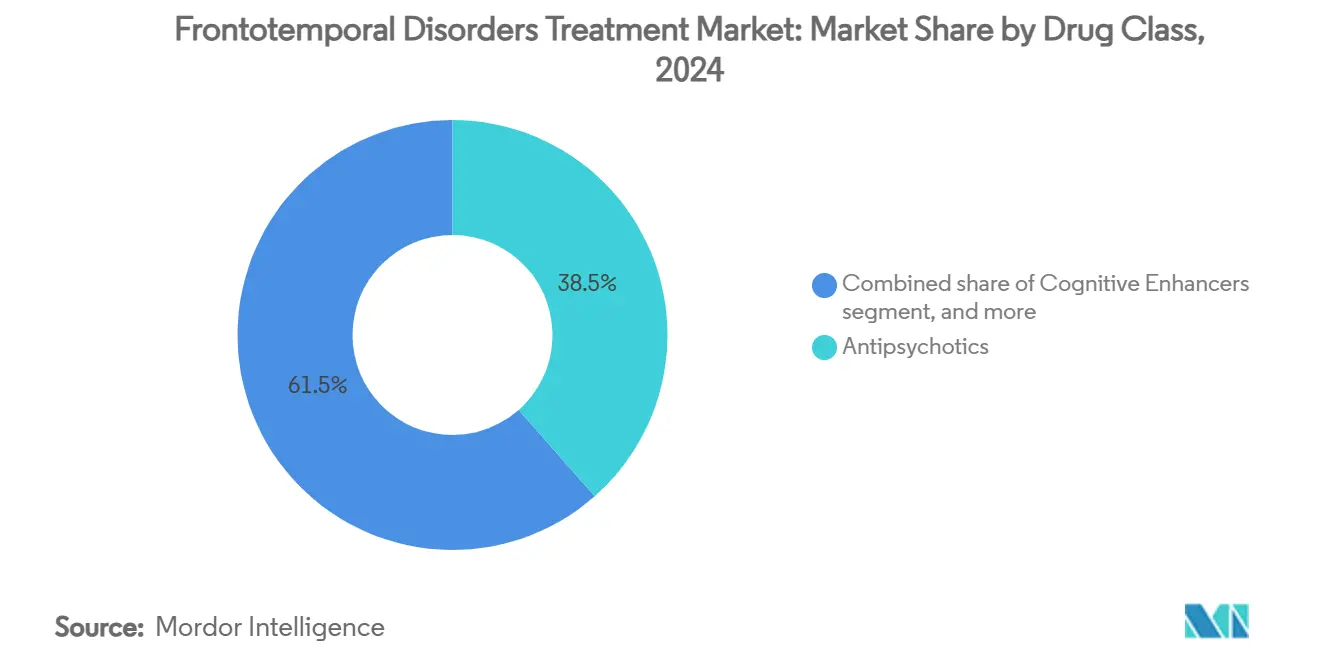
Note: Segment shares of all individual segments available upon report purchase
By Disease Indication: Movement Disorders Accelerate on Diagnostic Clarity
Frontotemporal dementia dominated with 48.56% share of the frontotemporal disorders treatment market in 2024, driven by well-established diagnostic criteria and reimbursement familiarity. Movement-disorder variants, however, are set to grow the fastest at an 8.23% CAGR as tau- and alpha-synuclein-targeting drugs align more tightly with phenotype-specific biomarkers. The frontotemporal disorders treatment market share for movement disorders stands to expand as imaging protocols that differentiate PSP from corticobasal degeneration become mainstream. Improved phenotype delineation also encourages targeted trial enrollment, boosting statistical power and drawing incremental capital toward niche indications.
Clinical-practice guidelines now recommend early speech-language therapy for primary progressive aphasia, but limited therapist availability constrains addressable volume. Device-assisted neurostimulation strategies are gaining foothold, yet reimbursement remains patchy outside academic hubs. Cross-indication lessons from Parkinson’s device programs may shorten learning curves and normalize procedures, but long-term cost-utility data are still evolving.
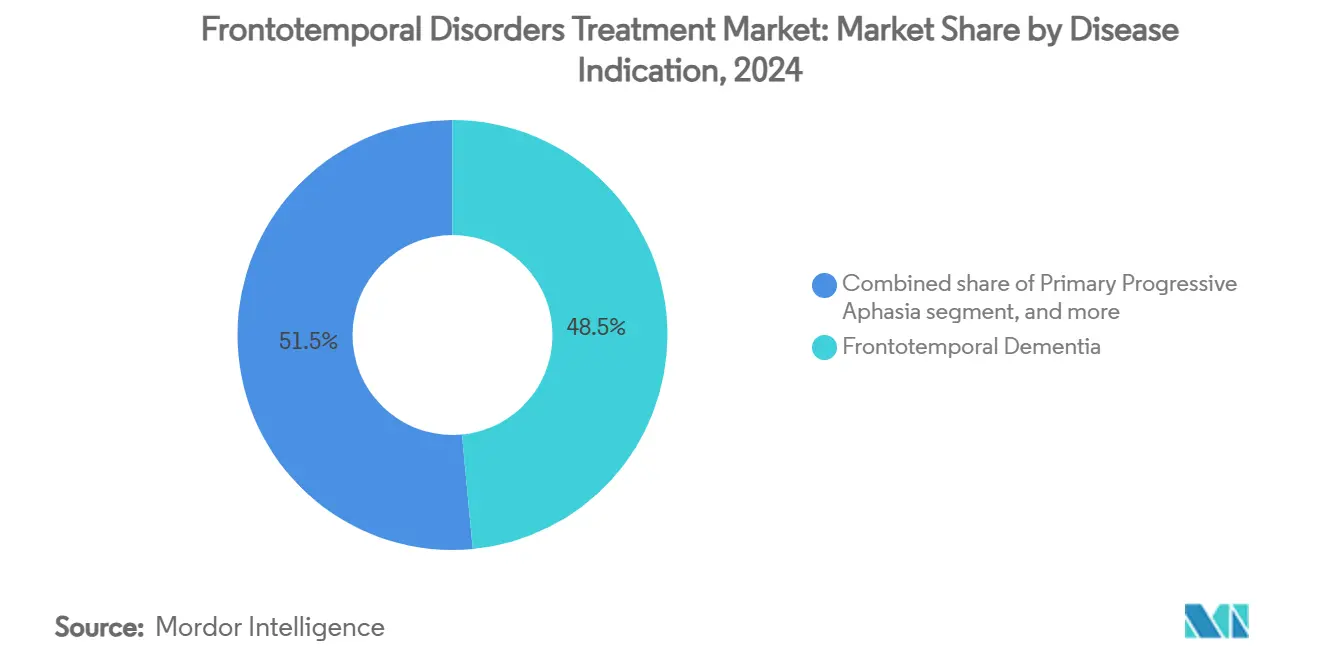
Note: Segment shares of all individual segments available upon report purchase
By Distribution Channel: Retail Pharmacy Uptake Reflects Shift to Home Care
Hospital pharmacies held 46.23% share of frontotemporal disorders treatment market size in 2024, rooted in infusion oversight and neurosurgical coordination. The growth of administration-at-home models now lifts retail pharmacies at an 8.65% CAGR, aided by Medicare reimbursement for subcutaneous antibodies delivered outside inpatient settings. Retail chains are expanding specialized counselling teams to manage neurobehavioral side effects and handle cold-chain biologics.
Online platforms secure modest but rising volumes through caregiver subscription models for oral symptom-control drugs; yet stringent controlled-substance rules and remote-monitoring demands restrain penetration into high-value gene therapies. Hospitals, cognizant of revenue leakage, pilot joint-venture infusion suites that extend clinical oversight into community settings. Collaboration between health-system pharmacies and home-care nurses is essential to maintain pharmacovigilance while meeting patient preference for fewer hospital visits.
Geography Analysis
North America accounted for 41.55% of global revenue in 2024, supported by early-access pathways such as FDA breakthrough designation and structured Medicare payment models covering cognitive-assessment visits. Strong biopharma clusters in California and Massachusetts anchor high trial density, ensuring that most transformative assets debut locally. Payers leverage real-world data networks to negotiate outcomes-based contracts, smoothing uptake for premium-priced innovations.
Asia-Pacific registers the quickest 6.45% CAGR to 2030, benefiting from aging demographics and rapid neurology infrastructure build-out. China’s introduction of blood-based FTD screening kits, pending regulatory clearance, is expected to shorten diagnosis by nearly one year, accelerating therapy initiation. Japanese insurers experiment with bundled payment models for gene-therapy follow-up, setting a precedent for neighboring markets. In India, the rise of urban super-specialty hospitals brings magnet centers capable of handling neurosurgical gene-vector infusions, though unequal rural access persists.
Europe remains an innovation contributor through cross-border research consortia spearheaded by the European Medicines Agency and Horizon Europe grants. Budget constraints lead some national health systems to stagger patient eligibility for high-cost therapies; nonetheless, Germany’s AMNOG framework offers predictable price negotiation timelines that attract launches. Regulatory realignment post-Brexit introduces additional dossier preparation for the United Kingdom, yet its accelerated access collaborative continues to prioritize rare neurodegenerative submissions.
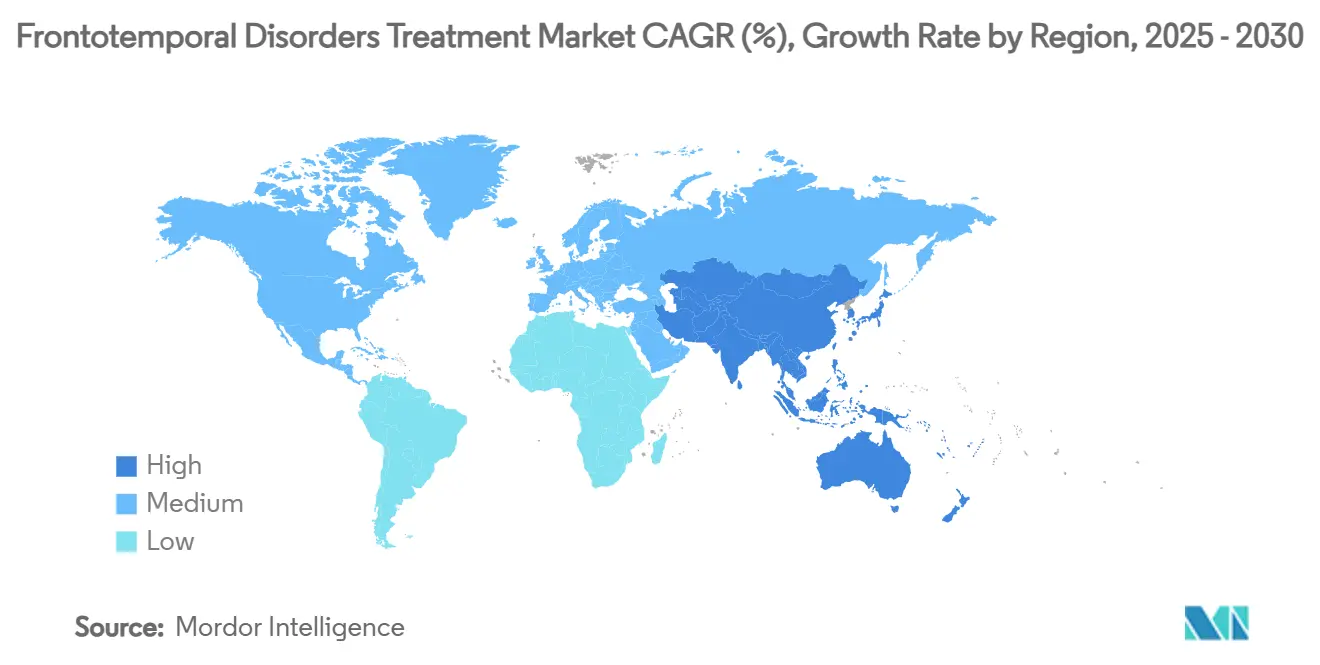
Competitive Landscape
The frontotemporal disorders treatment market skews toward moderate fragmentation as incumbent neurology firms share space with gene-therapy specialists and AI-driven startups. Biogen maintains brand recognition through Alzheimer’s monoclonal antibodies and extends that expertise with antisense tau programs that now enjoy FDA fast-track status. Roche refocuses pipeline capital on blood-brain-barrier-crossing antibodies after discontinuing a prior tau asset, while partnering with RNA-editing ventures to spread risk.
Alector’s latozinemab validates the sortilin-blockade concept and may serve as a bellwether for immuno-neurotherapeutics. AviadoBio leverages intrathalamic delivery vectors and secured a capital influx via Astellas to progress AVB-101, highlighting growing big-pharma appetite for external gene-therapy platforms. Asceneuron advances an oral OGA inhibitor financed by a USD 100 million round led by Novo Holdings, signalling venture willingness to underwrite differentiated small molecules.
Competition increasingly centers on integrated diagnostic-therapeutic packages: players pair blood-based assays with treatment algorithms to lock in brand loyalty. Artificial-intelligence tools that predict protein-folding dynamics accelerate target validation and shorten lead-optimization cycles, attracting cross-sector partnerships with cloud-computing firms. With multiple first-in-class entries forecast this decade, marketing strategies will pivot from broad neurologist detailing to genotype-driven, center-of-excellence outreach.
Frontotemporal Disorders Treatment Industry Leaders
-
Teva Pharmaceutical Industries Ltd.
-
Pfizer Inc.
-
AstraZeneca PLC
-
Biogen Inc.
-
Lundbeck A/S
- *Disclaimer: Major Players sorted in no particular order
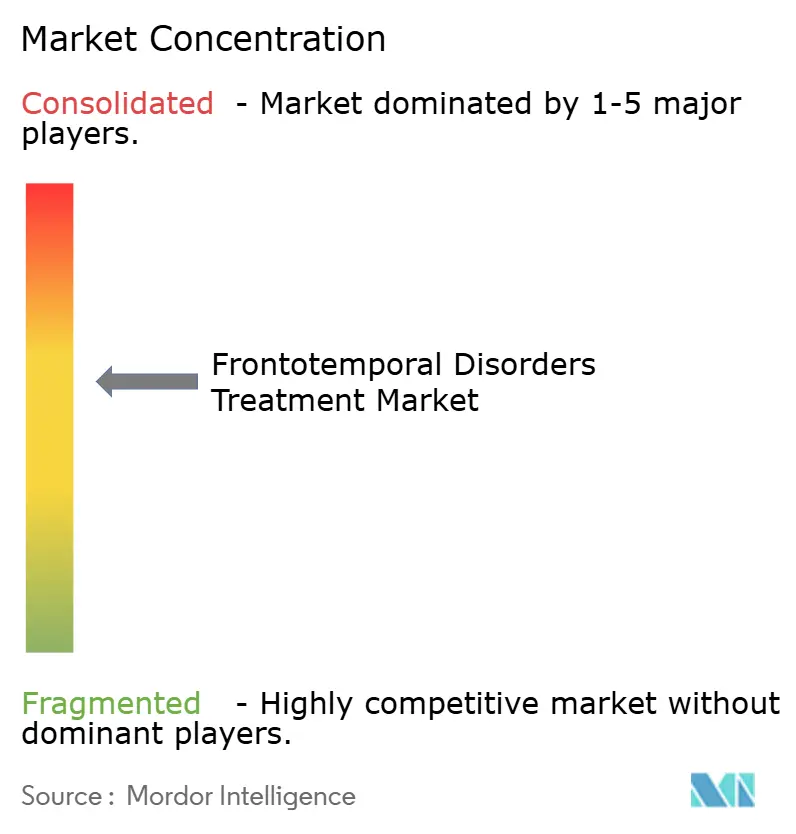
Recent Industry Developments
- May 2025: Sanofi agreed to acquire Vigil Neuroscience for USD 10.00 per share, adding TREM2 agonist VG-3927 to its neurodegeneration pipeline.
- April 2025: Biogen’s antisense candidate BIIB080 obtained FDA fast-track status for Alzheimer’s, opening the pathway for related frontotemporal applications.
- January 2025: FDA awarded breakthrough designation to latozinemab for progranulin-mutated FTD, underscoring the first disease-modifying approach in this subtype.
- December 2024: CervoMed’s neflamapimod earned orphan-drug designation for FTD treatment.
- October 2024: Astellas secured an option-license pact worth up to USD 2.18 billion for AviadoBio’s AVB-101 gene therapy.
- July 2024: Asceneuron raised USD 100 million in Series C financing to advance oral OGA inhibitor ASN51.
Global Frontotemporal Disorders Treatment Market Report Scope
As per the scope of the report, frontotemporal disorders are forms of dementia caused by a family of brain diseases known as frontotemporal lobar degeneration (FTLD). It majorly involves a severe loss of thinking abilities that interferes with a person's ability to perform daily activities such as working, driving, and preparing meals.
The frontotemporal disorders treatment market is segmented by drug class (cognitive enhancers, antipsychotics, antidepressants, CNS stimulants, and others), disease indication (frontotemporal dementia, primary progressive aphasia, and movement disorders), distribution channel (hospital pharmacies, retail pharmacies, and online pharmacies), and geography (North America, Europe, Asia-Pacific, Middle East, and Africa, and South America). The market report also covers the estimated market sizes and trends for 17 countries across major global regions.
The report offers the value (in USD million) for the above segments.
| Cognitive Enhancers |
| Antipsychotics |
| Antidepressants |
| CNS Stimulants |
| Other Drug Classes |
| Frontotemporal Dementia |
| Primary Progressive Aphasia |
| Movement Disorders |
| Hospital Pharmacies |
| Retail Pharmacies |
| Online Pharmacies |
| North America | United States |
| Canada | |
| Mexico | |
| Europe | Germany |
| United Kingdom | |
| France | |
| Italy | |
| Spain | |
| Rest of Europe | |
| Asia-Pacific | China |
| Japan | |
| India | |
| Australia | |
| South Korea | |
| Rest of Asia-Pacific | |
| Middle East & Africa | GCC |
| South Africa | |
| Rest of Middle East & Africa | |
| South America | Brazil |
| Argentina | |
| Rest of South America |
| By Drug Class | Cognitive Enhancers | |
| Antipsychotics | ||
| Antidepressants | ||
| CNS Stimulants | ||
| Other Drug Classes | ||
| By Disease Indication | Frontotemporal Dementia | |
| Primary Progressive Aphasia | ||
| Movement Disorders | ||
| By Distribution Channel | Hospital Pharmacies | |
| Retail Pharmacies | ||
| Online Pharmacies | ||
| Geography | North America | United States |
| Canada | ||
| Mexico | ||
| Europe | Germany | |
| United Kingdom | ||
| France | ||
| Italy | ||
| Spain | ||
| Rest of Europe | ||
| Asia-Pacific | China | |
| Japan | ||
| India | ||
| Australia | ||
| South Korea | ||
| Rest of Asia-Pacific | ||
| Middle East & Africa | GCC | |
| South Africa | ||
| Rest of Middle East & Africa | ||
| South America | Brazil | |
| Argentina | ||
| Rest of South America | ||
Key Questions Answered in the Report
What is the projected size of the frontotemporal disorders treatment market in 2030?
The market is forecast to reach USD 522.75 million by 2030, growing at a 5.12% CAGR.
Which drug class currently generates the highest revenue?
Antipsychotics lead with 38.54% share of 2024 global revenue.
Which region will grow the fastest through 2030?
Asia-Pacific is projected to expand at a 6.45% CAGR, outpacing all other regions.
What therapy has the first FDA breakthrough designation for FTD?
Latozinemab, an anti-sortilin antibody for progranulin mutations, secured breakthrough status in January 2025.
Why are retail pharmacies gaining market share?
Medicare coverage for home-infusion antibodies and the rise of subcutaneous formulations are shifting volumes from hospital to retail settings.
How fragmented is the competitive landscape?
The market scores 6/10 on concentration, indicating moderate fragmentation with the top five players controlling about 60% of revenue.
Page last updated on:
